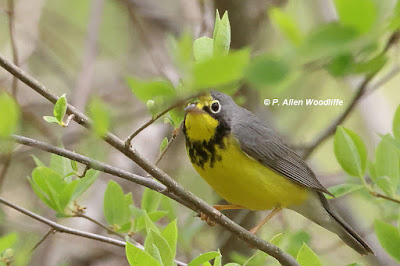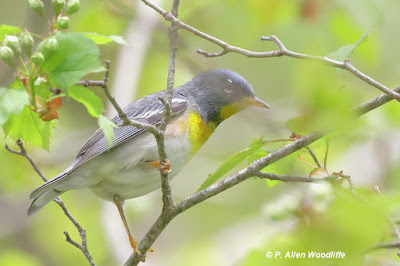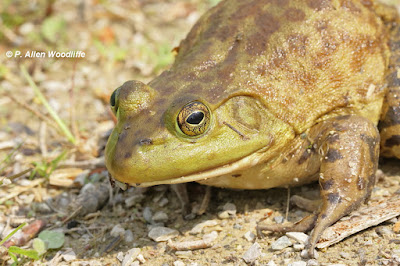It is a special highlight when the presence of a seldom seen endangered species, and in this case, a very cooperative one, occurs. I am referring to the endangered Loggerhead Shrike, quite a rarity even in its normal breeding range, which hasn't included southwestern Ontario for many decades. But one was seen a bit north of Erieau a few days ago, and for some reason has decided to stick around for several days. Not that the habitat is any good for breeding, as it is predominantly very open farmland rather than the open alvar habitat it prefers. I have been fortunate that it has decided to stick around, as during the first 3 days of its presence I was too pre-occupied with other things and couldn't get to see it. Fortunately this morning I managed to track it down and get a few photos, although the sky was quite bland.
I had driven by this spot a few moments before and the bird was not visible. When I did see it, it was quite busy preening. I suspect it had taken a bath in a close by creek, and then came up to the wires where it preened the entire time I watched it. Maybe if it sticks around a bit longer, I will get a photo of it looking sleek and with a nice blue sky background.
The warbler parade is well underway at places like Rondeau, and while I have seen quite a few of the ~30 plus species that regularly show up, I have not been able to get photos of them all. But some have cooperated for me, at least for a record photo, as follows.
 |
| American Redstart |
 |
| Bay-breasted Warbler |
More subdued is the Black-throated Blue Warbler, especially the female, shown first.
A species at risk is Canada Warbler, easily told by its gray back, white eye-ring, yellow throat and belly separated by a black necklace.
The female Cape May Warbler, next, is also quite subdued compared to the male.
The Northern Parula has been quite uncommon in some years, although it is fairly plentiful this year.
Yellow-rumped Warblers are typically the first one to arrive in spring, and some years the occasional one may even overwinter. There are still some around now, although they are often gone north by now.
Of course there are numerous other species to look for and enjoy. Eastern Kingbirds like open spaces, and this one decided sitting on a park sign along the beach was to its liking.
Gray Catbirds are quite numerous these days.
House Wrens are busily checking out potential nesting sites....
...or perched on a stub ready to declare its territory.
Red-headed Woodpeckers are not common, but are present in small numbers.
 |
| Savannah Sparrow |
Warbling Vireos, next, are fairly common, but are not terribly brightly coloured.
Not everyone likes the Brown-headed Cowbird, a female of which is shown next, but they have their role in nature.
Of course there are other critters to see along the way. This Bullfrog was right on the path, and although he puffed himself up as I walked by, he didn't move off.
This Common Five-lined Skink is anything but common. In fact it is legally endangered. The fairly bright orange face is indicative of its breeding condition.
And Northern Ribbon Snakes, shown next, are also a species at risk. It looks a lot like an Eastern Garter Snake, but the lines are a little more distinct with a brighter yellow, and there is a small white patch in front of its eye.
There is always something to see and appreciate! If it isn't birds, it is reptiles, amphibians, butterflies, wildflowers, fungi, etc., etc, or just the peaceful natural landscape!
If you would like to subscribe, or unsubscribe, to Nature Nuggets, send an email to: prairietramper@gmail.com

























Very good post Allen
ReplyDeleteThank-you!
Delete